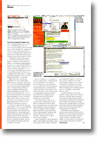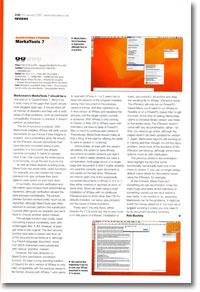
Review: QuarkCopyDesk 3.5
- Article 1 of 19
- MacUser, April 2006
Quark’s never been the most responsive of companies. So when you hear it’s been trying to respond to customer demands, a feeling of dread is probably the most that can be expected of anyone. It’s also never had much luck at selling any products except XPress – mainly because they’ve been so underwhelming – so the launch of a new Quark program isn’t something that anyone really looks out for.
Still, under the new-look Quark, times are a-changing so QuarkCopyDesk is something that should be given the benefit of the doubt – at least, at first.
CopyDesk isn’t really a new program, since it used to be part of the rarely bought Quark Publishing System. But Quark has decided to float it as a stand-alone package designed for use in conjunction with either XPress or XPress Passport Edition, depending on how much money you’re willing to spend.
Essentially, CopyDesk is a word processor than can handle special versions of QuarkXPress layouts. The idea is that the designer can create pages with XPress; when the designs are ready, they can export the layouts as CopyDesk files. Editors and writers can then use CopyDesk to flow their text into these layouts, rewrite it, reformat it, proof it and so on. When they’re finished, the designer imports their copy into the original Quark layout.
In theory, everyone should be happy: the designer should be happy because the editors aren’t able to mess around with any of the layout elements, only the text; the editors should be happy because they know exactly how many words they need to write, where sub-heads need to go and so on; and publishers should be happy because they don’t have to buy full versions of QuarkXPress for everyone.
How about in practice? Well, there are a few problems. Firstly, if you have any difficulties with versioning in your company, steer clear of CopyDesk. Since CopyDesk can’t use Quark layouts, only specially saved versions, there are going to be at least two copies of every file around. Although it should be easy, using naming schemes, etc, to prevent confusion, you just know that various editors are going to end up wiping over one version or the other.
Secondly, CopyDesk isn’t a very good word processing system. While CopyDesk is a slight improvement over XPress, since it includes word counts, line depths and other useful information in the standard Measurements palette, it’s still essentially QuarkXPress with the layout tools removed. That means editors, when given a choice between the useful spelling, grammar and editing tools of Word and the slightly anaemic CopyDesk dictionary, are almost always going to choose Word.
Thirdly, QuarkXPress 7.0 is due soon. It has a fine series of collaboration tools for allowing multiple users to edit the same layout simultaneously. Its composition zones allow designers to define what areas of a layout are editable. This makes CopyDesk slightly superfluous to anyone except the cash-strapped. Publishers might well be inclined to buy the full version of XPress 7, rather than the cutdown version that is CopyDesk.
Lastly, CopyDesk isn’t exactly identical to XPress. There’s different terminology: layouts aren’t layouts, they’re ‘articles’; text chains are ‘components’; tables of contents are ‘lists’; and so on. All these features are handled in different ways from XPress as well, which seems unnecessary and is going to confuse a few people from the outset. With the additional costs of training courses thrown in, CopyDesk no longer looks like such a relative steal any more.
There are some handy features in CopyDesk, however, many of which you wish were built into XPress. New to 3.5 are change-tracking and red-lining, which enable editors to keep track of what text has been changed and roll back any changes that shouldn’t have been made. An improved notes feature lets editors leave messages on layouts for other editors without recourse to text boxes on the pasteboard full of 72-point text. You can jump between notes using a sub-menu as well, making it far easier to find everything that needs your attention.
Nevertheless, QuarkCopyDesk is probably twice the price it should be for its features. If it were more like a word processor and less like a hobbled, slight confused version of XPress, it would be a useful addition to most workflows. As it stands, it’s a luxury most companies can do without.

